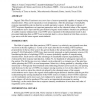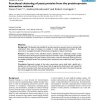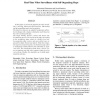954 search results - page 8 / 191 » Principles and Models for Organizing the IT Function |
MJ
2006
13 years 7 months ago
2006
Organic Thin Film Transistors are a new class of sensors potentially capable of outperforming chemiresistors. They can be operated at room temperature, offer the advantage of rema...
ICAC
2006
IEEE
14 years 1 months ago
2006
IEEE
Network resources will always be heterogeneous, and thus have different functionalities and programming models. This adversely affects interoperability. Seamless Mobility is one e...
BMCBI
2006
13 years 7 months ago
2006
Background: The abundant data available for protein interaction networks have not yet been fully understood. New types of analyses are needed to reveal organizational principles o...
JMIV
1998
13 years 7 months ago
1998
In the past decades linear scale-space theory was derived on the basis of various axiomatics. In this paper we revisit these axioms and show that they merely coincide with the foll...
CRV
2005
IEEE
13 years 9 months ago
2005
IEEE
In this paper, we present an approach for video surveillance involving (a) moving object detection, (b) tracking and (c) normal/abnormal event recognition. The detection step uses...



